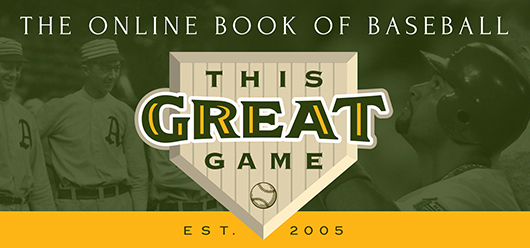THE TEAMS
The Diamondbacks’ Five Greatest Pitchers
 Randy Johnson (1999-2004, 2007-08)
Randy Johnson (1999-2004, 2007-08)
Tall, tense and equipped with a fiery fastball, the Big Unit was an impressive but raw talent in his early years with Seattle—but by the time he signed with Arizona in 1999, he had mastered the combination of 100-MPH fastballs and sliders that would unleash him into one of the most remarkable stretches of pitching yet seen in baseball.
In his first four years with the Diamondbacks, Johnson won 81 games (31 of them complete, 11 by shutout) and lost just 27; struck out 1,417 batters, the most by any pitcher in a four-year period; and became only the second pitcher ever to win four straight Cy Young Awards. His 2001 campaign was especially noteworthy; among his 372 strikeouts (11 shy of Nolan Ryan’s all-time mark), 20 came in one game and another 16 in a seven-inning relief appearance. Johnson also killed a bird with a fastball in spring training (the poor thing literally exploded into a cloud of feathers) and won three games in the World Series against the New York Yankees, the last in an effective Game Seven relief appearance just one day after throwing seven solid innings in Game Six. His 419 total strikeouts in 2001 are the most ever collected by a pitcher within a single year, regular and postseason combined.
A knee injury curtailed Johnson’s run in 2003, but he returned to top form a year later at age 40, highlighting the season by becoming the oldest pitcher to throw a perfect game. Despite a 2.60 ERA that year, Johnson could only compile a 16-14 record as he was rarely supported by a badly weakened (51-111) Diamondbacks team. After an unpleasant two-year stay with the Yankees, Johnson returned to Arizona—but he couldn’t recapture the magic of his first tour of desert duty, with a bad back largely to blame.
 Brandon Webb (2003-10)
Brandon Webb (2003-10)
Webb assumed the role of staff ace from Johnson and established a first-rate presence of his own in the late 2000s, racking up a 56-25 record over a three-year period (2006-08) dotted with a myriad of accomplishments. In 2006, Webb became the first Arizona pitcher not named Randy Johnson to win the NL Cy Young Award; in 2007, he strung together 42 consecutive scoreless innings, the longest seen in the majors since Orel Hershiser’s all-time mark of 59 in 1988; and he led the majors in 2008 with 22 wins but lost that year’s Cy to San Francisco’s Tim Lincecum, who won four fewer games yet had a superior ERA.
Visions of prolonged greatness for Webb were shattered in his first start of 2009 when he succumbed to a major shoulder injury; after three years and numerous comeback attempts with a number of teams, he gave up and announced his retirement in early 2013.
 Curt Schilling (2000-03)
Curt Schilling (2000-03)
The outspoken Alaska native joined the Diamondbacks from Philadelphia a year after Johnson arrived and paired with the Big Unit to form baseball’s most dominating 1-2 pitching punch since Sandy Koufax and Don Drysdale in the 1960s.
In his first full year with Arizona in 2001, Schilling led the NL in wins (22) and innings (256.2) and was brilliant in the postseason for the eventual world champion D-Backs, going 4-0 with a 1.12 ERA and striking out a postseason-record 56 batters (while walking just six) in 48.1 innings. Schilling shared not only the World Series MVP with Johnson (who was equally brilliant) but also the prestigious Sportsman of the Year honor from Sports Illustrated.
Schilling remained superb a year later, winning more games (23), throwing more innings (259.1) and striking out more batters (316) but led the league in neither category and finished runner-up for the second straight year in the NL Cy Young vote—to Johnson. In 2003, his final year in Arizona, Schilling lowered his ERA (to 2.95) but could only manage an 8-9 record, missing a month and a half to a hand injury. He signed after the season with Boston, where he regained the spotlight during the Red Sox’ magnificent 2004 postseason rally; he remained in it after his playing days, and not always for the right reason—running a video game company he started into bankruptcy, and having his on-air analyst job for ESPN terminated after the left-leaning sports network found his right-leaning social media posts to be leaning too far to the right.
 Zack Greinke (2016-19)
Zack Greinke (2016-19)
After an absolutely superlative season with the Los Angeles Dodgers in 2015, Greinke became one of the most sought-after free agents in baseball—and the Diamondbacks, in a stunning move, muscled their way through expected NL West foe signers in the Dodgers and Giants to give the right-hander a six-year, $202 million contract. Though Greinke didn’t match the greatness of that final season in Los Angeles, he still hardly disappointed in Phoenix—even as he complained every spring of reduced velocity, as if playing mind games with opponents who might let their guard down against the crafty veteran.
Greinke did struggle through a rough first campaign with Arizona—especially at home, where hitter-friendly Chase Field was not exactly the pitching Xanadu that he experienced at Dodger Stadium—but he still finished the year at 13-7; the next season, he won 13 at Chase Field alone, finishing with an overall 17-7 record and 3.20 ERA. Along the way, Greinke showed that throwing was far from his only big-league specialty; he won a Gold Glove in each of his first three seasons with the Diamondbacks, and become one of the majors’ most stubborn hitters among pitchers, even keeping opponents on their toes when he reaches base—stealing three bases in 2018.
It almost seemed inevitable that Greinke’s six-year stay in Arizona would be cut short by a mid-market franchise once there was a need to quickly slash payroll. Sure enough, the Diamondbacks dealt the right-hander—in the midst of another fine season at age 35—midway through 2019 to the contending Houston Astros.
 Zac Gallen (2019-23)
Zac Gallen (2019-23)
The New Jersey native’s path to Arizona—and stardom on the mound—was cleared for him midway through 2019 as part of a then-obscure, midseason trade from Miami for another future star in Jazz Chisholm Jr. It was a deal that neither team has yet to regret.
Well-armed with a solid if not overpowering fastball, mixing in the hard curve, change-up and cutter, Gallen quickly established himself as a tough cookie who would bend but never break. In each of his first 23 starts, he didn’t allow more than three earned runs; in each of his first 90, he never walked more than he struck out. Both streaks established MLB records. Yet these early gains yielded few wins; Gallen only won 10 of his first 50 starts despite an agreeable 3.46 ERA. His solution was simply to get better; late in the 2022 season, Gallen tied an all-time mark with six straight scoreless starts, part of an overall streak of 44.1 consecutive scoreless innings that set an Arizona team record while being logged as the seventh-longest in MLB annals.
In short order, the wins finally began to flow Gallen’s way, with 12 in 2022 and 17 in 2023. Though imperfect during the Diamondbacks’ eye-opening postseason run to the 2023 NL pennant, he still managed two wins and, in one of his three losses, took a no-hitter into the seventh in the decisive World Series Game Five against Texas, ultimately conceding a run in the team’s 5-0 loss.
Arizona Diamondbacks Team History A decade-by-decade history of the Diamondbacks, the ballparks they’ve played in, and the four people who are on the franchise’s Mount Rushmore.
The Diamondbacks’ Five Greatest Hitters A list of the five greatest hitters based on their productivity and efficiency.
The Diamondbacks’ Five Most Memorable Games A list of five memorable games and other notable personal achievements that have defined the Diamondbacks’ history.




